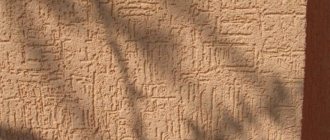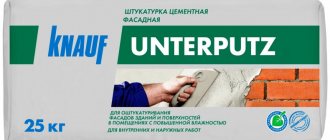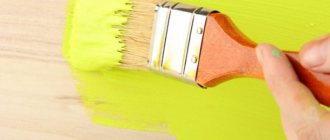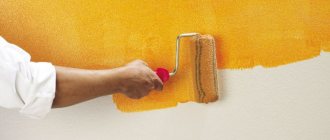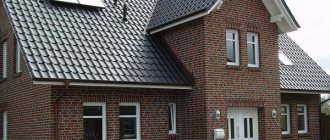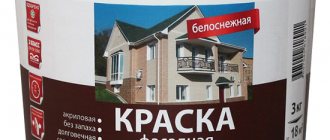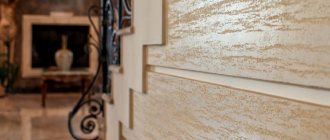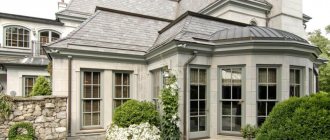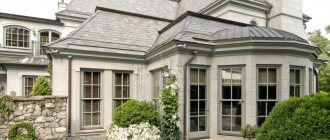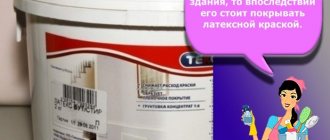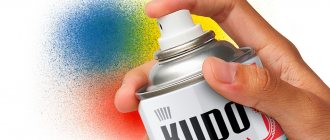Exterior paint determines the very first impression of the appearance of the house. Its quality and decorative capabilities determine how well the architect’s plans were justified and how carefully and skillfully the exterior decoration of the house was carried out.
Finally, by the appearance of the building one can judge the tastes and preferences of its owner.
At the same time, the functions of the facade coating do not end with the external, decorative qualities. A layer of paint protects walls, plaster and other materials from moisture, wind, and allows steam to escape from the inside (what is called “allows the walls to breathe”).
Such important tasks require the coating to have certain properties, without which their implementation is impossible. Therefore, manufacturers of facade paints spare no effort to accurately adhere to existing technologies and develop new, promising compositions for outdoor use.
Facade paint "Alpina" - description
The Alpina company is an excellent example of the traditional German approach to the quality and precision of paint and varnish production technology . The level of production of materials is confirmed by relevant certificates.
Strict quality control and compliance with technical parameters contributes to the emergence of elite materials that can compete with any similar products from other manufacturers.
Alpina facade paints are water-dispersed compositions for external use, based on acrylic or silicone resins . Available in:
- Base 1 . White paint can be used exactly in this capacity, or you can tint it in the desired color of soft pastel shades.
- Base 2 . Less opaque white base, has no independent use, is used for tinting in tones of medium brightness.
- Base 3 . It is a transparent base for tinting in bright, saturated colors.
Tinting - adding special tinting pastes that change the color of the mixture - is done manually or using special equipment . It should be taken into account that when obtaining dense, bright colors, the technical characteristics of the mixture change somewhat, so it is recommended to test the application on a small area in order to determine the compliance of the resulting composition with the existing conditions.
Alpina facade paints are created taking into account all the loads experienced by the coating during operation, and are able to effectively withstand natural phenomena or physical processes.
Consider the variety of palettes and shades:
Types of Alpina paints
Water-based (dispersion) compositions and latex dyes have been developed for interior decoration. The mixtures contain antifungal components. Acrylic – universal, suitable for all types of surfaces, including plastic.
There are three types of metal mixtures:
- Heat resistant for radiator;
- Hammer, creating a matte roughness effect;
- For rust containing reducing agents, anti-corrosion substances.
The most popular paints are worth considering in detail.
Water-based (dispersion) compositions and latex dyes have been developed for interior decoration.
Alpina Aqua Buntlack - water-borne tinted enamel
Universal composition, dries within 2 hours, hardens within 8 hours. Creates an easily cleaned porous film. Apply to primed or pre-treated wood surfaces, plasterboard, concrete, masonry, plaster.
Universal composition, dries within 2 hours, hardens within 8 hours.Alpina Direkt auf Rost Hammerschlageffekt - enamel directly on rust hammer effect
In the Alpina lines of paints for metal, enamel combines three properties:
- Decorative – a hammer effect is created;
- Protection of steels from oxidation;
- Also used as a primer for rust.
They are characterized by low consumption (100–120 ml), applied in one layer.
They are characterized by low consumption (100–120 ml), applied in one layer.
Alpina Expert Facade Silicone - water-dispersion silicone-modified paint
Creates a matte effect on concrete, plaster finishes, and primed sheet insulation. The resulting film is resistant to stains and is available in different colors. Dries within 2 hours, the top coat of varnish can be applied after 6 hours. It is durable.
Creates a matte effect on concrete, plaster finishes, and primed sheet insulation.
Alpina Die Langlebige fur Holzfassaden - durable paint for wooden facades
The uniqueness of facade coating for wood is its ability to emphasize the natural structure of wood. The thin-layer composition contains antifungal components, creates a film that is resistant to precipitation, temperature changes, and is not prone to cracking.
The uniqueness of facade coating for wood is its ability to emphasize the natural structure of wood.
Alpina Aqua Weisslack - water-based enamel for wood and metal
The snow-white mixture, which creates a silky-matte finish, can be tinted and used for facade and interior decoration. Alpina acrylic paint is diluted with water, applied in one layer, and the film hardens in the open air.
The snow-white mixture, which creates a silky-matte finish, can be tinted and used for facade and interior decoration.
Alpina Die Edle fur Innen - noble interior paint
It is recommended to cover the wallpaper with a latex mixture; it forms a thin translucent layer that is resistant to external influences and preserves the original structure. It is better to paint mineral bases in two layers, especially in places where there is heavy load. The film is not destroyed by detergents and is not afraid of wet cleaning.
It is better to paint mineral bases in two layers, especially in places where there is heavy load.
Alpina Die Samtene fur Innen - velvet interior paint
The composition is designed to create exclusive interiors. This Alpina interior paint for interior work has top-class hiding power, the mixture applies equally well to any surface, including structural wallpaper, and creates a healthy microclimate. Valued for its decorative effect created by finely dispersed natural ingredients. The film is resistant to cracking and retains its elasticity for a long time.
The composition is designed to create exclusive interiors.
Advantages and disadvantages of Alpina
Like any material, Alpina facade paints have their pros and cons. Let's take a closer look at them.
The advantages include:
- High hiding power of paints.
- Possibility of tinting in different tones - from light soft to denser and brighter.
- Low consumption, reduced amount of material.
- The elasticity of the paint allows it to withstand vibrations, minor shrinkage movements or seismic events without cracking.
- High vapor permeability.
- An environmentally friendly product that provides protection against mold, mildew, algae, etc.
- High water-repellent ability of the material.
The only disadvantages of Alpina facade paints include the high cost of materials , which is due to the complexity of the technological process and, as a consequence, the high quality of the products.
Product Overview
Alpina has a wide range of products. There are two categories of paints:
- For interior work. Such compositions can be applied to walls and ceilings made of different materials. The products can also be used in decorative work; there are enamels for metal, including rust.
- For outdoor work. This is primarily a façade paint for application to mineral surfaces, wood and metal products (roofs).
The company cares very much about its reputation and image, therefore all quality standards are strictly observed during production. Each material fully meets all global requirements and characteristics. On sale are interior paints, facade dyes, acrylic and water-based coatings, roofing compounds and much more.
For interior work
Alpina interior paints are conventionally divided into dispersion (water-based) and latex. The company presents several products from different series; let’s look at the characteristics of some of them in more detail.
Dispersive
This group includes water-based paints; due to the absence of harmful components and solvents, they are considered safe and environmentally friendly, do not have a strong odor and can be used for painting walls and ceilings in any residential premises. Let's look at a few popular products:
- Paint "Practical". This is a matte dispersion paint intended for painting walls and ceilings. The base can be any: concrete, plasterboard, brick or plastered surfaces. This paint has high hiding power and abrasion resistance, suitable for any type of room, be it a bedroom, living room, hallway or children's room. The material is economically consumed and affordable.
- “Durable” paint. It is also a dispersion paint that creates a durable silky matte finish that will withstand repeated cleaning. It can be used to paint walls and ceilings, as well as wallpaper. The paint has a classic white color, but with the help of the tinting system you can achieve absolutely any shades you need.
- Paint for kitchen and bathroom. The product is designed specifically for rooms with high levels of humidity, ideal for walls and ceilings in bathrooms, washrooms and kitchens. The paint is resistant to moisture and has dirt-repellent properties.
- Highly environmentally friendly paint. This product is ideal for painting walls and ceilings in children's rooms; it does not contain solvents, which means there is no unpleasant odor. The resulting coating is wear-resistant and can withstand heavy loads and frequent cleaning.
Latex
Among the paints intended for interior work, one can highlight the Megamax series. This is Alpina interior paint of the highest class. The product is latex-based, universal and can be used for painting a wide variety of surfaces. In addition, this option is ideal for interior work that is very minor. The surface will be silky matte after drying.
Among the main characteristics are the ability to apply the dye in a thin layer, good adhesion, high spreadability over the surface, beautiful texture, absence of harmful solvents, wear resistance, and good water-repellent properties.
As for colors, the base can be transparent or white. The desired shades can be obtained by tinting. The line also includes colored enamels of the same series for interior work - with their help you can get excellent results.
On video: how to choose paint for the interior.
For outdoor use
Dispersive
This includes exterior products intended for application to walls and facades. Wall paint can be applied both to old facades and new concrete surfaces, as well as to walls made of ceramic or silicate bricks. The material is also perfectly applied to metal, gypsum and cement plaster. The composition is made in such a way that the resulting coating reliably protects the wall from damage by mold and mildew.
Among the main properties are:
- high environmental friendliness;
- ease of application;
- coating resistance to wear;
- resistance to moisture;
- wall paint will not fade when exposed to ultraviolet radiation.
One of the brightest representatives of paints for exterior use is Alpina Expert Facade paint. The dye is intended for creating coatings that are resistant to various types of influences, as well as for application to vapor-permeable surfaces. After application, a durable protective film is formed.
The product has excellent coverage and UV resistance. The base color is white and the surface is matte. However, the manufacturer offers a wide selection of colors due to the possibility of tinting.
The line of facade paints also includes other products: “Super-resistant”, “Reliable”, facade paint for wood, as well as paints for roofs.
Acrylic
Acrylic paint of this brand not only provides excellent surface appearance, but also protects wooden structures. It can be applied to the surfaces of gazebos and fences, facades and other wooden elements. The product is an acrylic enamel that adheres well to metal and plastic surfaces.
Among the features of the paint are the following:
- good weather resistance;
- high vapor permeability characteristics;
- water repellency;
- wear resistance;
- ease of application;
- high adhesion to any materials.
- Possibility of use for interior work.
The palette is not very diverse, the base color is white, but with the help of a large palette of colors you can manually create any desired shade. The paint dries quickly and has high hiding power - low consumption. It only takes 2 hours to dry completely and you can apply a second coat. Approximate consumption – 120 ml/m2.
Technical characteristics of Alpina facade paint
Alpina facade paint has the following main characteristics:
- Consumption - 150 ml/sq. m. (10 liters of paint is enough for about 70 sq.m.).
- Drying time - 4-6 hours at 20° , the next layer - after 12 hours.
- Type of application - mechanical and manual.
- Thinner - water . For the first layer, dilution (maximum) 10%, for the second - 5%.
- Application temperature - from +5° to 30°.
- The guaranteed shelf life in a closed original container is 24 months from the date of manufacture.
IMPORTANT!
The guaranteed shelf life of the product is relatively short , so you should pay attention to the release date when purchasing. If it is not on the package or is impossible to read, it is better not to take this package.
Paint composition
The composition of the paint depends on the specific brand.
There are silicone mixtures that include:
- Acrylic dispersion.
- Silicone-modifying additives.
- Pigment, mineral fillers.
- Additives (special additives to obtain certain properties).
- Water.
For acrylic mixtures, the typical composition includes:
- Acrylic dispersion.
- Water.
- Pigments, mineral fillers.
- Additives.
In fact, the difference lies only in the composition of the base of the mixture - the dispersion of certain resins that form the coating film. Fillers or pigments are substances that form texture and create the color of the material (for untinted mixtures it is white).
Calculation of Alpina paint consumption per 1 m2
The consumption stated in the manufacturer's documentation is 140-150 ml/sq.m.
This makes it possible to cover approximately 70 sq.m. surfaces with one 10 liter can.
At the same time, it should be taken into account that tests in laboratories are carried out under ideal conditions - optimal temperature and air humidity are created, the tested material is applied to a smooth surface with a certain absorption coefficient.
In practice, such conditions cannot be achieved, so you should calculate the required amount of paint with a margin of 20-25% , as experts recommend.
A test application to a section of the wall in an inconspicuous place will help determine the consumption more accurately (ideally, the back of the house, invisible from the street, but it can also be applied to a separate surface).
NOTE!
For trial application, the base must be the same as on the facade of the house.
What surfaces is Alpina suitable for?
Alpina facade paints can be used on almost any substrate:
- Concrete.
- Facing and ordinary bricks (clay, silicate, etc.).
- All types of plaster (cement, lime, textured mixtures).
- Old dispersion coating.
- Dispersion putties.
It is recommended to keep freshly applied lime-cement plasters for 4 weeks to remove carbon dioxide from them and complete chemical reactions.
Surfaces with high absorbency (porous or cellular materials, aerated concrete, etc.) should be pre-primed with appropriate primers with antiseptic properties.
When using plasterboard boards, you can do without preliminary priming.
Advantages and disadvantages of acrylic-based interior wall paints
The modern market is overflowing with offers, thanks to which the buyer has no difficulties when choosing and purchasing consumables that are necessary to carry out the planned types of work. Acrylic-based paint can be applied to substrates made of almost any material, the main thing is that the working surface must be carefully prepared. The popularity of the material is explained by the following advantages:
- Durability of use, the applied layer does not fade under direct sunlight, the paint does not crack with sudden changes in humidity and temperature.
- The paint is excellent for finishing walls and ceilings in rooms for various functional purposes.
- Affordable cost, which will allow you to purchase consumables inexpensively in the volume of interest.
- The paint dries quite quickly after application, which allows you to perform large volumes of work efficiently with little loss of time and effort.
- A large selection of colors makes it easy to choose the material to implement your design ideas.
Like any other modern material, the products in question also have disadvantages, the main ones being:
- Some coatings attract dirt and dust, but they can be easily removed with a damp sponge.
- Once the applied layer has dried, it is almost impossible to remove it without using a special tool.
- Paint application must be carried out strictly according to the manufacturer's instructions; the quality of application is ensured provided that professional tools are used and experience in performing such work is available.
Nuances and finishing technology
The wall surface must be prepared for application of the finishing coat.
It is necessary to provide:
- No hanging elements, brackets, lights or air conditioners.
- Cleaning and removal of shedding, peeling, efflorescence and other unstable areas of walls.
- Removal of all separating elements (oil stains, varnish coatings, etc. areas with poor adhesion to water-dispersed paints).
- Preliminary priming of the surface with appropriate compounds.
Paint is applied in dry weather, preferably without scorching sun or strong wind. Operating temperature - from +5° to +30° . The prepared and primed wall surface must be dried, and the plaster must be cured for at least 4 weeks.
The paint can be applied by spraying or by hand using a roller or brushes.
The coating is applied in two layers:
- The first layer is diluted with water by 10%.
- The second layer is diluted by 5% and applied no earlier than 12 hours after the first.
CAREFULLY!
Paint is applied using the “one plane at a time” principle . If this is not possible, a sufficient number of painters should be hired to ensure the correct technology is used. Connections of layers applied at different times are made along the corner edges.
The use of Alpina facade paints is the creation of a high-quality finishing coating for a home that protects against unwanted influences - moisture, wind, dirt or biological manifestations (fungus, mold).
The highest German quality has a downside - the costs of such coverage will be quite high, but they are completely justified . The coating will provide high-quality long-term service without loss of properties throughout the entire operation, create a harmonious aesthetic appearance of the house and protect the wall material from unwanted contacts with external manifestations.
The choice of Alpina paints is a mature decision, dictated by the desire to do everything thoroughly, at the highest level.
Methods and technologies for painting walls with Alpina paint
Painting walls only at first glance seems like a simple undertaking, but in fact, it’s not so. In some cases, only experienced craftsmen can do the job efficiently. Painting walls must be carried out in compliance with a number of rules and taking into account the following key stages:
- Old finishing material is removed from the surface to be painted.
- The base is carefully leveled, cement mortar and finishing plaster are used.
- The working base must be primed. This is done in order to increase strength and improve adhesion of the paint to the base. Note that the primer must have a similar base to the paint that will be used in the future.
- Additionally, the wall surface can be treated with an antiseptic and antifungal solution.
- You can start painting the wall after all applied layers have dried thoroughly. The paint is applied with a roller, brush or spray gun.
Alpina brand interior paints are especially popular today, which is explained by the numerous advantages of the material. Therefore, if you want to purchase high-quality products at an affordable price, with the help of which it is guaranteed that you can implement any design ideas of any complexity with high quality, then purchasing Alpina interior paints would be an excellent solution.
